| Previous Facts & Stories | Facts & Stories Index | 16th OVI Home Page | Next Facts & Stories |
of the 16th Ohio Volunteer Infantry
During early 1863, the 16th Ohio and thousands of Gen. Ulysses Grant's troops were massed just north of Vicksburg, Mississippi, camping along the river while waiting out the long, cold winter. They were staged here in preparation for a springtime offensive against Vicksburg, hoping to take the strategic city from the Confederates and fully open the Mississippi River to Union control. The Rebels had formidable defensive works all along the river but Union Admiral Porter frequently attempted to run the blockade with his ironclad gunships, often sustaining serious loss.
On February 24 a powerful gunship, the U.S.S. Indianola, was lost to the Confederates during action around Palmyra Island, a large island about 20 miles south of Vicksburg. The Union was horrified to watch the Rebels attempt to recover the ship and add it to their defensive arsenal.
On February 25 some Union troops had the idea to build a "dummy" ironclad warship from the parts of an abandoned flatboat, logs and other nearby materials. They would use this fake gunship to try and draw fire from the Confederate batteries and also to hopefully distract the Rebels from pursuing the Indianola. A detailed description of the construction of what was to be named Black Terror
was written by Donald L. Barnhard, Jr. for America's Civil War magazine:
Starting with an abandoned flatboat, Porter put his command to work constructing his ruse. Tapered logs were added to the sides of the flatboat to give it a hull-like appearance. Canvas and wooden planks were used in the center to form a casemate, pilothouse and paddle-wheel housings. Two unusable lifeboats were bolted to fake davits for further realism. Blackened logs served as the vessel's weaponry. Pork barrel smokestacks were added to either side of the pilothouse. For a dark, sinister appearance, the exterior was blackened with tar. As a final touch, two iron pots filled with tar and oakum were placed at the base of the smokestacks and ignited. Clouds of black smoke curled upward as the ersatz ironclad was set adrift in the Mississippi current. Dubbed Black Terror, she was built in 12 hours for a mere $8.63.
Barnhard goes on to describe the deployment of Black Terror
and the amazing results:
At 11 p.m., on February 25, Black Terror was towed into the Mississippi, cut loose and sent on her journey. After cruising past Vicksburg, the vessel struck the west bank of the Mississippi near Warrenton, but Union soldiers pushed her back into the current, and soon Black Terror was drifting at 5 knots. Confederate crewmen on Queen of the West saw Black Terror approaching and turned about and headed downriver to warn any vessels of the Union's latest threat. Coming upon the wrecked Indianola, Captain McCloskey of Queen warned the salvage party of the ironclad's approach. The frightened salvagers decided to scuttle Indianola to prevent her recapture. The guns were spiked or thrown overboard. What was left was set on fire, burning her down to the waterline. Colonel Wirt Adams, commander of a nearby cavalry regiment, remarked, 'With the exception of the wine and liquor stores of the Indianola, nothing was saved. The valuable armament, the large supplies of powder, shot and shell are all lost.' Black Terror, her mission completed, drifted on for two more miles, then struck a mudbank. She fired no shots and no crew members appeared on the deck. Curious about the lack of any crew activity, a Confederate party from ashore rowed toward the silent vessel. Upon closer inspection, they realized too late the duplicity.
The hoax had worked beyond the Union's wildest expectations. But how does this relate to the 16th Ohio? The article, below, published in the Pittsburg Post-Gazette on March 12, 1913 (and originally by the 16th Ohio's hometown newspaper, the Wooster (Ohio) Republican), tells a story, from an unnamed source, that four soldiers from the 16th Ohio were instrumental in coming up with the idea of the hoax and working to make it happen. These soldiers were:
Pvt. William Bigham
Cpl. John C. Hall
Pvt. David McCulley (listed as Dan in article below)
Cpl. Samuel Metzler
all of Company C. Whether this story is true or not is hard to say. The fact that actual names of four, identifiable soldiers of the 16th Ohio were listed and that the 16th Ohio was certainly with Grant's troops along the Mississippi River gives credence to the story. That Admiral Porter took credit for the idea, or rather, those who reported on it chose to give that credit to the much revered officer, is not unusual in the way history gets recorded.
The webauthor will be searching for the original poem mentioned in the article, below, and in the meantime chooses to believe those four young soldiers from Company C had a lot to do with this colorful, historic event.
Thanks to 16th Ohio researcher Rob Garber for the article. Rob is the 3rd great nephew of Capt. William Buchanan, Company F, and has provided much research and contribution to this website.
Cpl. John C. Hall
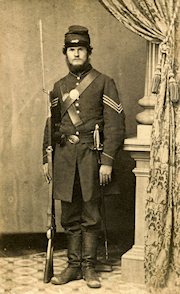
|
Article from the Pittsburg Post-Gazette, published March 12, 1913. 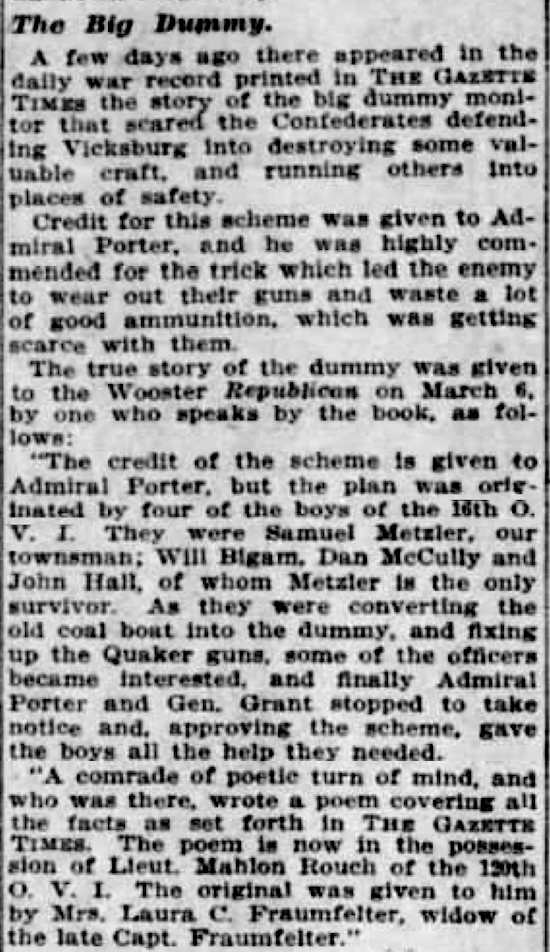 |
Cpl. Samuel Metzler 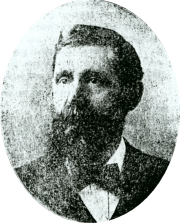 |
Artist's rendition of the 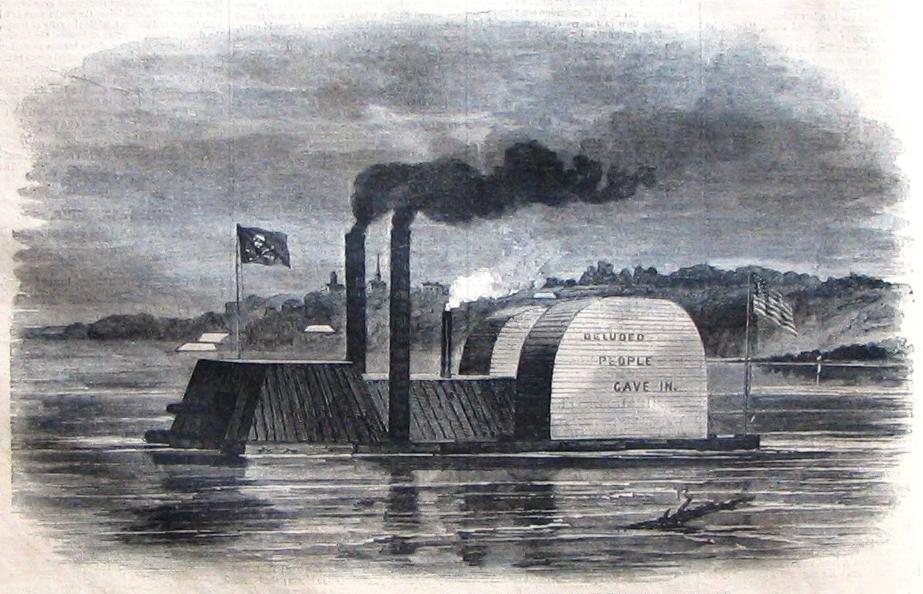 |
Image of U.S.S. Indianola, the ironclad gunboat captured by the Confederates and which spurred the hoax.
Image from Wilson's Creek National Battlefield collection. Note: Some sources dispute this photo is of the Indianola.
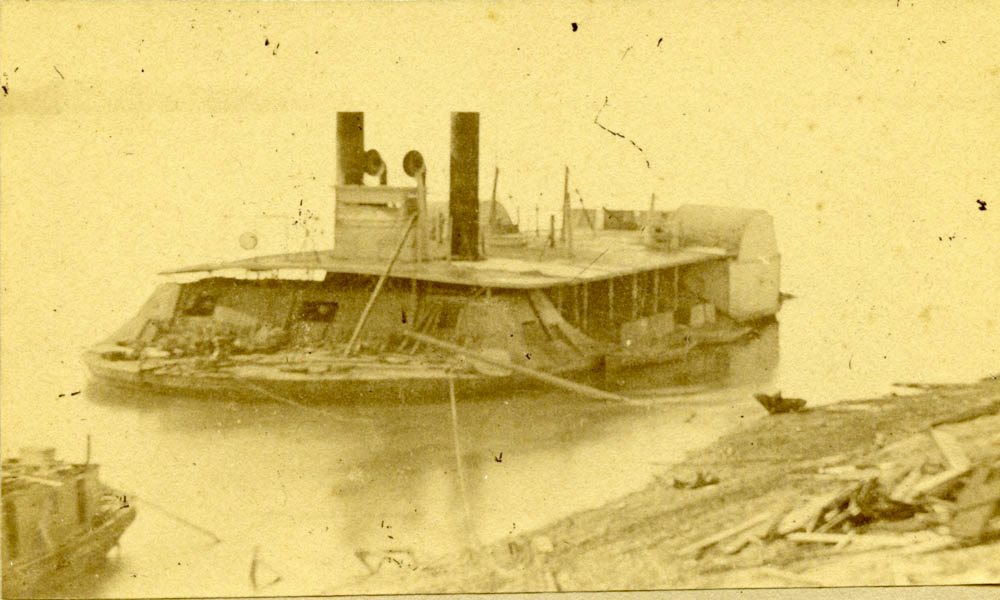
| Previous Facts & Stories | Facts & Stories Index | 16th OVI Home Page | Next Facts & Stories |